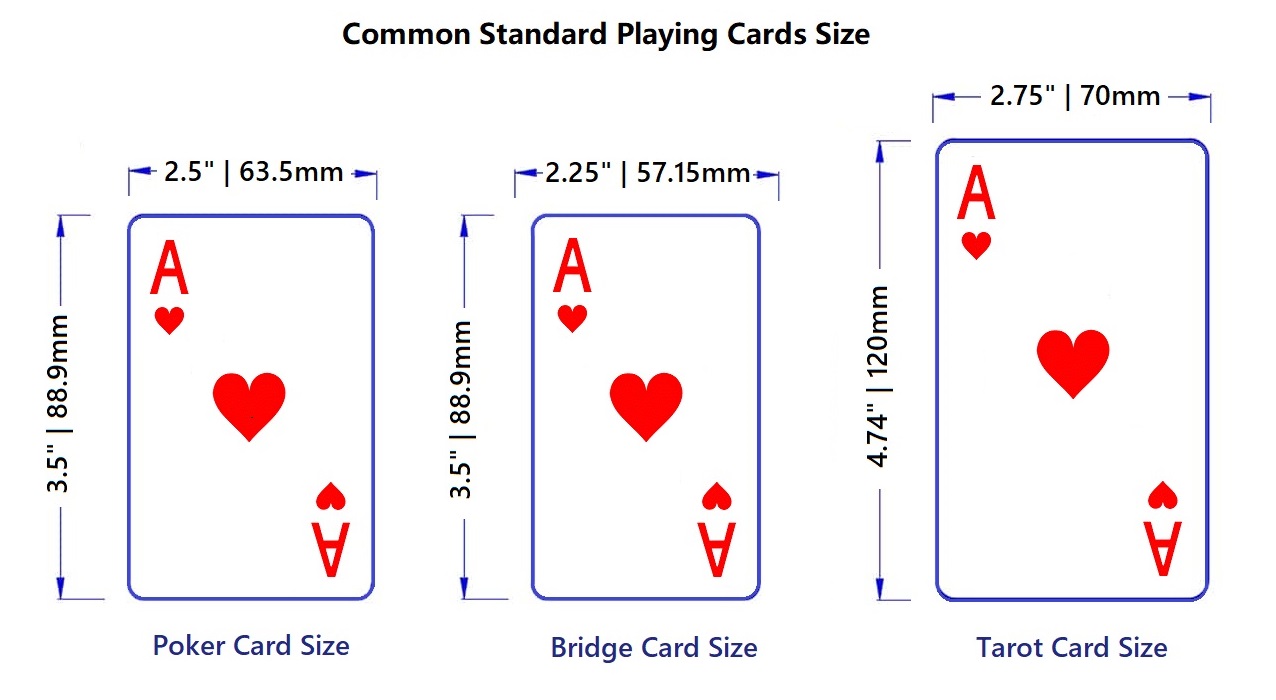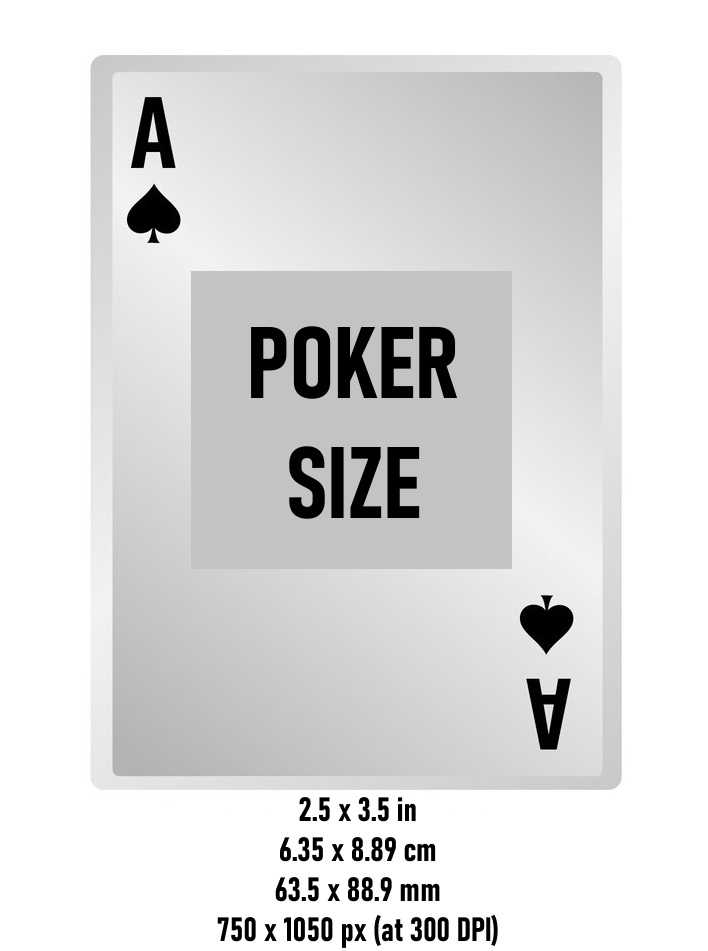Playing cards are a staple of entertainment and gaming culture worldwide. Their dimensions, designs, and materials are carefully crafted for ease of use, durability, and versatility. In below content, we will explore the standard playing card size of different kind, as well as variations used in different games and regions.

Common Playing Card Sizes
Poker Card Size
Poker card is the most common playing card worldwide, especially for games like poker, blackjack, and baccarat. Its size is standardized globally, and the dimensions are designed to fit nicely in the hand and be easy to carry, also provide better visibility for detailed card designs.

Poker card dimensions in different units of measurement:
- In inches: 2.5 x 3.5
- In cm: 6.35 x 8.89 cm
- In mm: 63.5 x 88.9 mm
- In pixels: 750 x 1050 px (at 300 DPI)
Poker Card Dimensions Chart
| Name | Inches | Centimeters (cm) | Millimeters (mm) | Pixels (300 DPI) |
|---|---|---|---|---|
| Poker Card Size | 2.5 x 3.5 inches | 6.35 x 8.89 cm | 63.5 x 88.9 mm | 750 x 1050 px |
* PPI (pixels per inch) = DPI (dots per inch) = Resolution
300 PPI is the best printing resolution of digital printer.
Bridge Size Playing Card Size
Bridge size is narrower than poker card size, making it easier to hold and shuffle multiple cards. It is used primarily for games like bridge and canasta.

Bridge card dimensions in different units of measurement:
- In inches: 2.25 x 3.5
- In cm: 5.72 x 8.89
- In mm: 57.15 x 88.9
- In pixels: 675 x 1050 (at 300 DPI)
Bridge Card Dimensions Chart
| Name | Inches | Centimeters | Millimeters | Pixels (300 DPI) |
|---|---|---|---|---|
| Bridge Size Playing Card | 2.25 x 3.5 inches | 5.72 x 8.89 cm | 57.15 x 88.9 mm | 675 x 1050 px |
* PPI (pixels per inch) = DPI (dots per inch) = Resolution
300 PPI is the best printing resolution of digital printer.
Mini Playing Cards Size
Mini cards are popular for travel games, promotional items, or novelty decks. Their compact size makes them portable but less practical for extended gameplay.
Mini playing card dimensions in different units of measurement:
- In inches: 1.75 x 2.5
- In cm: 4.45 x 6.35
- In mm: 44.45 x 63.5
- In pixels: 525 x 750 (at 300 DPI)
Mini Playing Card Dimensions Chart
| Name | Inches | Centimeters | Millimeters | Pixels (300 DPI) |
|---|---|---|---|---|
| Mini Playing Card | 1.75 x 2.5 inches | 4.45 x 6.35 cm | 44.45 x 63.5 mm | 525 x 750 px |
* PPI (pixels per inch) = DPI (dots per inch) = Resolution
300 PPI is the best printing resolution of digital printer.
Jumbo Playing Cards Size
Jumbo cards are used for stage magic, group games, or for players with visual impairments. Their large size allows for bold, easy-to-read designs.
Jumbo playing card dimensions in different units of measurement:
- In inches: 3.5 x 5
- In cm: 8.89 x 12.7
- In mm: 88.9 x 127
- In pixels: 1050 x 1500 (at 300 DPI)
Jumbo Playing Card Dimensions Chart
| Name | Inches | Centimeters | Millimeters | Pixels (300 DPI) |
|---|---|---|---|---|
| Jumbo Playing Card | 3.5 x 5 inches | 8.89 x 12.7 cm | 88.9 x 127 mm | 1050 x 1500 px |
* PPI (pixels per inch) = DPI (dots per inch) = Resolution
300 PPI is the best printing resolution of digital printer.
Tarot Card Size
Tarot cards are used for divination, readings, and spiritual practices. Their larger size accommodates intricate illustrations and symbolic details.
Tarot card dimensions in different units of measurement:
- In inches: 2.75 x 4.75
- In cm: 7 x 12
- In mm: 70 x 120
- In pixels: 825 x 1425 (at 300 DPI)
Tarot Card Dimensions Chart
| Name | Inches | Centimeters | Millimeters | Pixels (300 DPI) |
|---|---|---|---|---|
| Tarot Card | 2.75 x 4.75 inches | 7 x 12 cm | 70 x 120 mm | 825 x 1425 px |
* PPI (pixels per inch) = DPI (dots per inch) = Resolution
300 PPI is the best printing resolution of digital printer.
Square Playing Cards
Square cards are used for modern or novelty card games. Their unconventional format makes them a favorite for designers and indie game creators.
Square playing card dimensions in different units of measurement:
- In inches: 3 x 3
- In cm: 7.62 x 7.62
- In mm: 76.2 x 76.2
- In pixels: 900 x 900 (at 300 DPI)
Square Playing Card Dimensions Chart
| Name | Inches | Centimeters | Millimeters | Pixels (300 DPI) |
|---|---|---|---|---|
| Square Playing Card | 3 x 3 inches | 7.62 x 7.62 cm | 76.2 x 76.2 mm | 900 x 900 px |
* PPI (pixels per inch) = DPI (dots per inch) = Resolution
300 PPI is the best printing resolution of digital printer.
Comparison Chart of Common Playing Card Sizes
| Card Type | Inches | Centimeters | Millimeters | Pixels (300 DPI) |
| Poker Card Size | 2.5 x 3.5 | 6.35 x 8.89 | 63.5 x 88.9 | 750 x 1050 |
| Bridge Card Size | 2.25 x 3.5 | 5.72 x 8.89 | 57.15 x 88.9 | 675 x 1050 |
| Mini Playing Cards | 1.75 x 2.5 | 4.45 x 6.35 | 44.45 x 63.5 | 525 x 750 |
| Jumbo Playing Cards | 3.5 x 5 | 8.89 x 12.7 | 88.9 x 127 | 1050 x 1500 |
| Tarot Cards | 2.75 x 4.75 | 7 x 12 | 70 x 120 | 825 x 1425 |
| Square Playing Cards | 3 x 3 | 7.62 x 7.62 | 76.2 x 76.2 | 900 x 900 |
Custom Sizes
Custom cards can vary greatly in size and are often designed for specific games or promotional purposes.
Regional Variations in Playing Card Sizes
US
- Standard Size: Poker size (2.5 x 3.5 inches) is the most common.
- Specialty Cards: Jumbo cards are popular for family games or magic shows.
Europe
- Bridge Size: More commonly used than poker size for traditional card games.
- Tarot Cards: Widely popular for divination and artistic collections.
Asia
- Regional Sizes: Mahjong decks and hanafuda cards have unique dimensions.
- Mini Cards: Compact decks are common for travel and smaller tables.
India
- Ganjifa Cards: Traditional Indian playing cards are often circular, with intricate hand-painted designs.
Material and Design Considerations
-
Card Stock:
- Standard playing cards are made from coated paper or plastic for durability.
- Premium decks use casino-grade card stock.
-
Finish:
- Matte or glossy finishes affect shuffling and handling.
- Textured finishes (linen or embossed) provide grip and longevity.
-
Corner Style:
- Rounded corners are standard to prevent wear and ensure smooth handling.
Design Tips for Playing Cards
-
Resolution: Design cards at 300 DPI for sharp, professional printing.
- Example: A poker card design should be 750 x 1050 pixels.
-
Bleed and Safe Area:
- Include a bleed area (typically 0.125 inches) to prevent edge cropping.
- Keep text and essential details within a “safe zone” inside the card’s border.
-
Typography:
- Use bold, legible fonts for numbers and suits.
- Ensure high contrast between text and background for readability.
-
Back Design:
- Symmetrical designs are common for poker and bridge decks to prevent revealing cards.
Applications of Different Playing Card Sizes
-
Gaming:
- Poker size is ideal for cas*no games and card tournaments.
- Bridge size is perfect for games requiring large hands of cards.
-
Magic Tricks:
- Jumbo cards are used for visibility during stage performances.
-
Collectibles and Art:
- Tarot cards and custom decks are often artistic or thematic, catering to collectors.
-
Promotional Items:
- Mini or custom-sized cards are popular for branding and giveaways.
Questions?
Playing card sizes vary based on their intended use, cultural preferences, and game requirements. From the ubiquitous poker and bridge sizes to unique formats like tarot and square cards, each size serves a specific purpose. If you want to learn more about playing card size, or you have any questions, please let us know.